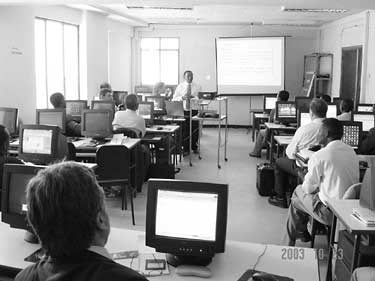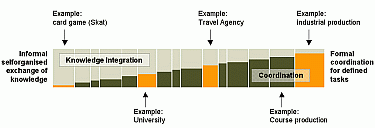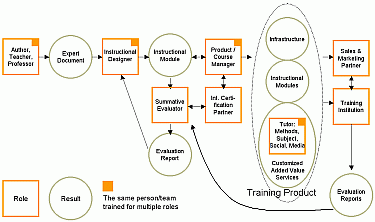The GTZ/Crystal workshop on Open Source based content management and eLearning at the University of Addis Ababa in October 2003.
Organisational building in educational ICT projects in Africa: The Ethiopian case
International Learntec Forum, Baden-Baden/Germany
Feb 9th 2004: Advanced learning technologies for educational systems are high on the agenda in Africa. Governments and donor agencies look at them as the only option to achieve one very important Millenium goal which is primary education for all children by 2015. Although it remains to be seen whether this ambitious goal is realistic considered the little time available, all actors believe that only through modern information and telecommunication technologies (ICT) the efforts undertaken will have an impact.
Sir John Daniels, Assistant General Manager for Education of UNESCO asked about two years ago, how the 15 million teachers necessary to provide primary education for every child by 2015 will become a reality? His answer: "You're not going to train 15 million just by adding a few seats in traditional teacher training establishments."

Today many African countries have embarked on large scale eLearning infrastructure programmes in order to address their urgent need for access to and outreach of education.
In 2004 the Ethiopian government is launching the US$ 40 Million "Ethiopia-ICT- Assisted Development Programme" which has a focus on building a national eLearning infrastructure and is financed by the World Bank.
In this paper strategies for an organisational framework to become integrated in an eLearning infrastructure programme are described. These strategies are currently under discussion between the World Bank, donor agencies and the Ethiopian government. The suggestions in this paper are based on experiences from a number of recent projects of GTZ in Africa and Asia, namely those of the BMZ sector project CRYSTAL.
Introduction
How much does a university cost, and how much costs the infrastructure supporting the out-put of 15 million teachers in a little bit more than 10 years?
If we look at the annual budget of a German university with about 20.000 students and an annual budget of EUR 150 Million, we can imagine what kind of financial magnitude we are looking at when talking about the Millenium Goal of providing primary education to all children and the prerequisite of about 15 million teachers to be deployed.
The proposition of advanced learning technologies is that with the help of ICTs already existing institutions will be enabled to increase the output and outreach both from a significant qualitative and a significant quantitative point of view.
If such a statement is viewed as a mere theoretical assumption, then a "reality check" will show that many developing countries have already embarked on this strategy.
In the planning process of all programmes financed by the World Bank ICT is already considered as a common determinator. In this context "ICT" is not "just a tool" as it is often called in a way to actually downplay its growing key role in development. To the contrary, ICT has been established rapidly as a horizontal layer through many development programmes of the World Bank.
In addition -; and this is even more significant - many countries have launched very ambitious ICT programmes for the educational sector which are - compared to the large scale European "Schools on the Net" initiatives in the 90ties - astonishingly ambitious and imply much more radical change to the educational systems, the stakeholders and the society as a whole than what had to be absorbed in the European countries.
In Ethiopia the Government is currently launching a large scale infrastructure programme networking 550 highschools and all 12 regional distributed universities. At the same time an eGovernment programme is on its way networking 600 local district offices and strengthening the federal local authority system. The "Ethiopia-ICT-;Assisted Development Programme" to be launched in summer 2004 will assist these infrastructure programmes by financing supporting measures such as training of stakeholders and organisational building.
There are three relevant critical issues in the context of capacity building and development cooperation the supporting measures should address.
Three critical issues and lessons learnt
- Training programmes provided in development cooperation programmes are in many cases not produced in a way that an ownership is achieved by the southern recipients. In other words, training often takes place as multiple singular events. There is in most cases no productisation process that results in training packages which can be re-used and adapted by the southern partners.The Northern training providers are usually not used to view their service as something that needs to be developed and managed like a product and that becomes replicable, adaptable and - most of all - transferable as a service to be further enhanced and deployed by the recipients themselves. Open Source applications today have become a serious requirement in the South. "Open Content" of training programmes as standardized, open, re-usable and adaptable content is still a relatively new concept.
- Education is viewed as an immaterial good that is delivered by an educator and through personal interaction. Its quality is only revealed in the process of delivery. Where as in distance education the productisation of courses is well known as a pre-condition for providing services efficiently, traditional universities are not familiar with this concept. The existing culture of producing and disseminating content at most universities should be seen as a major stumbling block for any dearly needed productisation process to be introduced, when education is delivered via networks.
- Many training programmes do not take the working environment of the participants - which is usually not in favour of the newly acquired skills - into consideration. This stumbling block cannot be tackled by including a "transfer component" into the training programme that intends to help the trainee to apply the new knowledge at the workplace. One will need to go a step further and include organisational development. It should in fact become a prioritised out-put indicator that in parallel to training an, appropriate organisational infrastructur is actually constructed in which the newly acquired qualification can become embedded.
It has been suggested that the "Ethiopia ICT - Assisted Development Programme" should address these three critical issues and lessons learnt through a number of specific programme features.
Instructional design, course production and publishing will become key activities in the networked universities
It seems obvious that the new nationwide learning network in Ethiopia will change dramatically the way universities provide and distribute their services. Because the networks require the materialisation of knowledge into media and the production of eLearning programmes, course production and publishing will need to become a core activity of faculties.
Subject matter experts, such as professors - enabled by training on instructional design and by the provision of Open Source publishing applications - will need to become involved in the production and distribution of content.
For the educational institutions this scenario would have far reaching consequences with regards to qualification requirements, workflows and the workplace itself.
Are traditional universities within their current organisational structures ready to productise their academic programmes? Usually not, because content is owned by each professor individually and is thus regarded as a personal intellectual property. It is elaborated individually in the study, distributed orally in lectures, scribbled at a blackboard and published as a paper.
When knowledge is produced cooperatively in an academic environment, it is done so in a self organised way, rather than in a formal coordinated fashion. The relationship between the two approaches in universities -; self-organisation and coordination - is usually about 65% self organisation to 35% coordination, as can be seen in the graphic below.
Graphic: adopted from the "Fraunhofer for Industrial Engineering - IAO document "Knowledge-Integrative and Coordinative Service Activities - Success Factors for a Sustained Competitive Advantage, Theses and Issues of a New Research Initiative"
Knowledge intensive services allow for rather flexible forms of coordination and cooperation. Schedules are not tight, processes are not standardized and it's the individual performance that counts. The graphic that is shown above gives an overview on the variety of cooperation modes that range from the self-organized and informal to highly formalised working styles - from card players to industrial production. Course production is shown as rather formally organised at this scale, whereas a university allows much more room for self organization.
As one can see at this graphic the development of content as a product within an academic institution will require a publishing approach which is rather different from the traditional content elaboration and representation in universities. This is a challenge because different work cultures are expected to become blended.
It will need an appropriate organisational infrastructure that supports the stakeholders to establish a "work culture mosaic" - meaning: the integration of a set of different working styles - that allows efficient course production and course distribution.
Content and service as a product
Content on the Internet needs to be dealt with as a product. In other words content is the result of a development process and a workflow involving different stakeholders with different competencies. As a product content has a life cycle in which conceptualisation, design, development, maintenance, adaptation, further development and "phasing out" takes place.
Since we are talking here about the production of e-learning courses technical competencies with regards to applications, platforms and publishing are needed in addition. The following graphic is an example of "Service blueprinting". It shows a workflow for instructional product development and deployment established already in eLearning academies in northern countries.
Graphic: Service blueprinting is part of "Service Engineering" that identifies all relevant activities of the service provision process. Workflow designed by Hoffmann & Reif.
In the content development scenario of this graphic the author represents the subject matter expertise, he does the instructional design, provides the tutoring and in addition functions also as the product/course manager.
Through a suite of publishing and collaboration applications the author is enabled to undertake and manage a significant portion of the value creation chain. At a certain development stage of the organisation one might want to introduce a higher degree of division of work. But even then, it is an important strategic decision to combine the three specific competencies - instructional design, tutoring and course management - within the role of the author at the initiation of the programme.
Blending technology with learning poses requirements that determine the solutions to be developed and the skills to operate them, be it as a producer, teacher or administrator. Guiding learners via an Internet learning portal demand specific pedagogical skills with regards to the functionalities provided, such as chat, bulletin board, e-mail and media. Content needs to be constructed along the lines of the technical environment in which it is represented.
Furthermore content as a product needs to be embedded in a business plan. It has a defined market, development costs, a prize, customers and possibly or hopefully revenues.
In this scenario one can see that instructional design and course management know-how are important components that are supplementing the work of an expert author. As stated above this scenario introduces rather new aspects to an academic institution. Furthermore bringing together a multidisciplinary team in order to fulfill the demands of a productisation process embedded in a business proposition increases significantly complexity.
Organisational development in Ethiopia: a national eLearning Competence Center
Without proper organisational frameworks new skills provided for university staff will not be able to have an impact and will even quickly get lost. Individual capacity building needs to be complemented with organisational capacity development. The new skills in "Instructional Design" and "Course Management on Networks" need to become embedded in an organisational structure that provides space, time and resources. Last but not least these organisational infrastructures themselves need resources and sustainability.
The tight linking of the two issues - productisation of knowledge in the networked universities and the appropriate organisational infrastructure - should become an important feature of the Ethiopian ICT - Assisted Development Programme.
It is suggested that with regards to the need of an organisational framework, the Ethiopian Programme should initiate an eLearning competence center in an existing national teacher training college. This eLearning competence center should then become the driving force for the utilisation of the educational network infrastructure in Ethiopia.
It is planned that within three years 150 Ethiopian professionals will be trained as eLearning experts. They will be employed by the eLearning Competence Center and its distributed satellites within the regional universities.
The staff of the eLearning Competence Center should
- develop, maintain and manage eLearning courses for the faculty in five selected regional universities;
- train distributed professors to become eLearning course authors and course providers;
- further develop, maintain and manage a national eLearning Portal through which all training and support is delivered both to professors and students;
- further develop, maintain and manage eLearning courses on the national eLearning Portal directed to students using the facilities of the nationwide distributed learning centers of the Schoolnet;
- further develop, maintain and manage accreditation, certification, quality control and examinations;
- manage distributed eLearning tutors and provide further training to them.
The first courses to be delivered by the eLCC :
- Instructional Design and the Management of Blended Learning and
- eLearning Content Publishing,
- and a number of IT centric TVT courses, as well as courses on
- Hotel Management, Construction, Electricity and Business.
The relevance of these two course packages as capacity building blocks is significant:
- Instructional Design, eLearning and content publishing are fundamental pillars for the national content development in the educational sector. Content development is a top priority within the Ethiopian ICT strategy as defined in 2002 by the Ministry of Capacity Building;
- The suggested courses address the urgent need in Ethiopia for improving the quality of existing TVET programmes, supporting the evolving new TVET faculties and providing access to training to the growing technical labour force in the country.
The German contribution to the eLearning Competence Center would be a package that can become the basis for the further development, maintainance, management and distribution of eLearning programmes:
- an Open Source based eLearning platform (the eLCC Portal) which consists of a learning-content-management system (LCMS) and allows the production and delivery of SCORM compatible content and learning applications;
- an eLearning Standard Operating Procedure (SOP) that defines standards for the production and delivery of instructional content on the Internet;
- an accredited e-readiness and eLearning orientation programme as an introduction to eLearning for 2700 TVET teachers;
- an accredited six month blended learning comprehensive eLearning programme for the development of eLearning capacities that includes modules such as Instructional Design, the Management of Blended Learning and eLearning Content Publishing.
Organisational building: Conclusion
The "Ethiopia- ICT-Assisted Development Project" is aiming at enabling knowledge owners to represent directly their knowledge through media via an already existing ICT network infrastructure. The advancement of learning applications makes it possible that academic subject matter experts cover elements of the educational value chain that in the past could have only be handled by publishing experts and expensive external services.
The establishment of an eLearning Competence Center should provide the organisational framework through which the acquisition and further distribution of eLearning skills and eLearning programmes will be achieved. Furthermore the eLearning Competence Center will ensure that productisation and distribution of training will meet the requirements of all universities and schools.
It is assumed that the direct representation of content by its owners - supported by an appropriate organisational framework and advanced ICTs - will result in a higher degree of authenticity, contextuality, adaptability, cost-efficiency and time-to-market of content.
Manuel Castell has described this new potential in his unsurpassed words: "Unprecedented productivity potential can be achieved when appropriate applications -; and I may add here: the appropriate organisational frameworks - empower humankind with the ability incessantly to feed knowledge back into knowledge and experience into experience".

